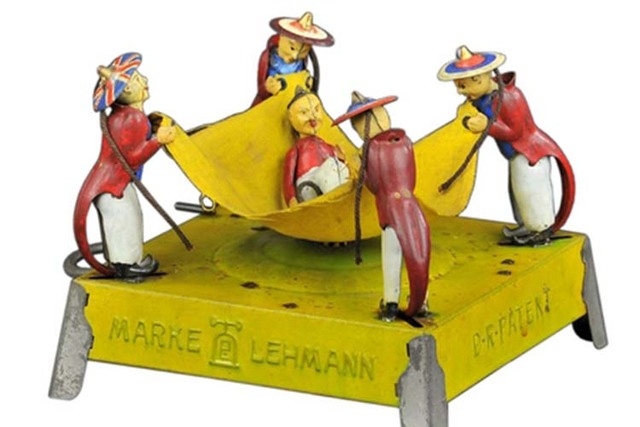A toy’s value also can be found in history
Sometimes an antique toy tells an almost-forgotten story. The Tammany Hall bank with a well-dressed man taking the penny is a criticism of corrupt politicians in New York City in 1871.
A 1940s blond doll wearing ice skates probably is not recognized today as Sonja Henie, a world-champion ice skater from 1923 to 1936 and star of 12 Hollywood movies.
A very rare clockwork toy has four Chinese men tossing a child in a blanket. Each of the men has a brightly painted hat that represents a European country. The toy, made in the early 1900s by Lehmann in Germany, is a comment on the Boxer Rebellion of 1900, when England, Russia, France and Germany occupied China. A Chinese secret society, the Boxers, led a rebellion against the European countries, killing foreigners and Chinese Christians and destroying property. An international army that included Americans subdued the uprising. The rebellion ended in 190l, and China paid $330 million in reparations. It seems like a strange idea for a toy. It is claimed that only four of the toys still exist because the action required a complicated mechanism that broke easily. So in recent years, one of these toys in good working condition sold for $14,800.
Q: Can you tell me anything about a clear pressed glass serving bowl left to my husband by his grandmother? The inside is marked “Mountain City Mills, patent, flour.”
A: A grain-milling company (or two different companies) named Mountain City Mills was in business in Chattanooga, Tenn., and Frederick, Md., in the early 1900s. It’s unusual to find a piece of pressed glass marked like yours. It is possible that Mountain City contracted with a glass manufacturer to make pieces either for employees or as a premium for customers. Pressed glass is not as popular with collectors as it was 20 years ago. Depending on the pattern and size of your bowl, it could sell for $25 or more.
Q: My mother has had a mint-condition alligator purse since about 1940. The inside is labeled “Cuba.” Can you tell me what it’s worth?
A: Back in the 1930s, ’40s and early ’50s, Cuban manufacturers sold a lot of goods in the United States. Those were the same decades when alligator purses were at their peak of popularity. If the purse is in excellent condition, it probably would sell for $20 to $50. If it had a high-end designer label, it could sell for many times that.
Q: I inherited an antique stove and would like to sell it. It’s a standing, round stove, and I assume it’s a wood-burning model. It’s black with metal accents and is marked “Great Western Stove Co., Leavenworth, Omaha, Denver.” Where can I sell it, and how much can I get for it?
A: We receive many questions about antique stoves. The history of the Great Western Manufacturing Co. of Leavenworth, Kan., dates back to 1858. The related stove manufacturer, Great Western Stove Co., was formed in 1875 and operated into at least the 1930s. We have seen Great Western stoves offered for $100 to more than $1,000. Take a look at the website AntiqueStoves.com to get an idea of the types of stoves collectors are looking for and selling. Then you might want to try selling locally through a dealer or via Craigslist so the buyer doesn’t have to worry about shipping costs.
Q: I have a tea set that I can find nothing about. It has a teapot, sugar and creamer and eight cups and saucers and is in mint condition. The pattern name is “Hawthorn” and it looks like Belleek, but I can’t find any other information. Can you help with age and value?
A: Your tea set was made in Ireland by the Donegal Parian China Co. The company was formed in 1985 in Ballyshannon, County Donegal, by a group of former workers from the more-famous Belleek Pottery, just five miles away, across the border in Northern Ireland. Donegal China made marble-like Parian tableware and giftware in the Belleek style decorated with shamrocks, roses, hawthorn and other Irish designs, but the intricacy of the pieces was never that of traditional Irish Belleek. In 1996, Donegal China became a subsidiary of Belleek Pottery, which closed the Donegal China factory in 2005, dissolved the brand completely in 2012 and discontinued the Donegal Parian lines. Your tea set is worth about $250.
Q: I have a milk glass rolling pin with wood handles that my mother got in 1931, and I got it when I married in 1954. I use it all the time and love it. Does it have any value?
A: Rolling pins were first used over 1,000 years ago. Early pins were handmade of wood. Rolling pins made of wood, glass, porcelain, marble, tin, and other materials were mass-produced beginning in the mid-19th century. In 1864, a rolling pin with a central rod that didn’t turn with the rest of the rolling pin was invented by John W. Reed, a black American inventor. Rolling pins that are decorated, carved or have advertisements on them sell for more than plain pins. A milk glass rolling pin without decoration but with a brand name sells for about $15.
Tip: Repairs made to cut glass can be seen with a black light. It also will show most added plastic repairs. Look at where the foot, knob or handles might have been reattached. Many auctions have a black light available at the preview.
Terry &Kim Kovel’s column is syndicated by King Features. Write to: Kovels, (Las Vegas Review-Journal), King Features Syndicate, 300 W. 57th St., New York, NY 10019.

















